Such a tropical plant as the orchid has long been an excellent decoration for houses and apartments. It is also widely used in the interior design of offices and shopping centers. There are florists who successfully grow dozens of various orchids (and even more) in their apartment. It is very easy to understand such flower growers, because a blooming orchid looks very impressive. Each of the varieties of this flower has something unique, original. Bushes can vary both in color and size, and in shape. And when a florist acquires a new orchid, he is convinced that it is more beautiful than all those in his collection. But this is until he has another copy.
Content
The main problems in growing orchids
Despite the fact that you are the owner of only one orchid bush so far, you need to know how to care for it so that it does not die, but pleases you with its flowering for a long time. It should be remembered that if you provide such an epiphyte with proper care, then there will be much fewer problems in the process of growing it.
At the same time, do not forget that problems with such a plant most often arise only from the fact that the grower does not adhere to the rules of caring for it.
Orchid leaves turn yellow
Most often, flower growers note that the leaves of such a flower begin to turn yellow. It should be remembered that in each of the plants at a certain time the leaves change their color to yellow and begin to dry out, which is an absolutely natural process. Examine the bush. In the case when old leaf plates become yellow, which are usually located at the very bottom, then you should not worry. Thus, the orchid is renewed. Only after the leaf is completely dry, it will need to be carefully removed.
However, in the case when the yellowing touched the young leaves, we can say that the plant is painful. As a rule, it gets sick due to improper watering:
- If the soil is waterlogged, rot can quickly appear on the root system, which will lead to yellowing of the foliage.
- In the event that the earthen lump is overdried, then the leaf plates of the orchid will begin to fade. At the same time, the same result will be if the room has excessively low air humidity, and the grower does not regularly spray the foliage from the sprayer.
- In winter, the leaves of the bush may begin to turn yellow due to the fact that a draft affects it. Also at this time it is not recommended to keep the orchid near a window or in a room where it is relatively cold. Leaves turn yellow due to strong cooling or freezing.
- If in the summertime direct sunlight falls on the foliage, they can burn them. As a result, yellow or brownish spots remain on the surface of the leaf plates.
Orchid root problems
If the orchid is not properly cared for, then problems with its root system may well begin. Examine the roots. If they became slimy and became lighter in color or darkened (became dark brown), then this instance was watered incorrectly.
In the event that you think that the plant should receive as much moisture as in the wild during rainstorms, then you should remember a few important facts. The fact is that after the downpour has passed, all the water is absorbed into the soil or drains from the bark of trees, but does not stay in it for a long time. Therefore, the roots of the orchid absorb as much water as they need. That is, the roots are not constantly in the water. If, in room conditions, such an epiphyte is watered "from the heart", then the water will stagnate in the substrate, from which the roots will begin to rot. In the event that you find clear signs that the flower has suffered from heavy watering, then urgent measures must be taken. Experts advise transplanting this flower into a new substrate, while you should carefully examine the root system and cut off all rotten and diseased roots.
Also, do not forget that this tropical plant needs moisture. In this regard, try not to forget to regularly, or rather, every morning, spray its foliage from a spray bottle. To do this, you need to use lukewarm water, which must be filtered or defended.
Orchid does not bloom
It is not so rare that flower growers note that their "beauty" for some reason does not want to bloom. In most cases, there is such a situation when flowering has already been observed several times, but when the next period of dormancy has ended, the orchid for some reason does not release a peduncle.
Most often, this problem occurs when the flower does not have enough light. As a rule, it is in the winter time that the illumination is rather scarce. At this time of year, most orchid species have a dormant period, which explains the lack of flowering. Phalaenopsis are advised to provide supplementary lighting using artificial lighting. In this case, they will continue to bloom further.
Carefully cut off the peduncle after flowering, it will be possible only after it is completely dry. However, if it does not dry out and at the same time has a green or pale brown color, then most likely, young flower buds will form on it after some time.
What to do when this epiphyte does not want to bloom anymore? Such a plant needs stress. In order for the buds to be laid in room conditions, orchids need a temperature not higher than 10-12 degrees, and at this time it must be watered rather poorly. However, it is by no means possible to drastically lower the air temperature and reduce watering. This should be done gradually. It should be remembered that this plant in such a period needs a difference between night and day temperatures. So, in the daytime you need warmth, while at night it should be 10-12 degrees cooler. The result of this plant maintenance should be the laying of a flower bud.
If you take care of the orchid in this way for 4-6 weeks, then in most cases your efforts will be crowned with success. As a rule, during this time, the budding should have already occurred. In the event that the buds still did not appear, it is necessary to carefully remove the flower from dormancy.This will require a gradual increase in temperature. You need to water the orchid more and more.
In the event that this epiphyte has not bloomed after 6-12 months, then you should not worry too much about this, because a young peduncle can form in about 24 months.
Orchid pests and diseases
Such flowers are quite resistant to diseases and pests, but problems still happen. Most often, rot appears on the plant. It is formed due to waterlogging of the soil and the plant itself. So, if you violate the watering regime and make it more abundant or frequent, as well as significantly increase the number of sprays, this can lead to rotting of the root system, as well as leaf plates (especially their bases) and bulbs. In this case, the plant is not easy to cure. The affected area must be carefully cut out with a very sharp disinfected knife along with a part of healthy tissue. Then it is necessary to process the cut with a special solution with bactericidal properties, which can be bought quite easily. The substrate and container should be replaced, while the pot can be boiled well if desired.
Of the harmful insects, mealybugs and spider mites most often start on the orchid. If there are few of them, then you can try to get rid of them with a solution of soap, which you need to wipe the leaf plates 2 times with an interval of 7 days. If the infection is very strong, then you need treatment with Aktar or Fitoverm.
Proper home care for orchids
Illumination
For such a plant, illumination plays an important role. Light is needed diffused and there should be a lot of it. In this regard, the flower should be placed on the lightest window (except for the southern one). However, it must be remembered that it must be protected from direct sunlight.
How to water
Despite the fact that such plants are tropical, too frequent and abundant watering can greatly harm them. In the wild, most species of such plants do not grow on soil, but on trees, clinging to their bark with their roots. Such epiphytes take moisture from the tree bark, which flows down after rain, but does not accumulate. In this regard, such flowers should be watered sparingly. Between waterings, the substrate should dry out well, and care must be taken to ensure that the roots are not constantly in the water. You can often moisten the leaves from the spray bottle, but make sure that the liquid does not end up on the flowers, as in this case specks will appear on them and they will turn dark. Orchids such as Phalaenopsis, Cymbidium, Odontoglossum Pafiopedilum need more abundant watering. With extreme caution you need to water Dendrobium, Cattleya and Oncidium. Make sure the substrate is dry before watering them.
In summer, watering should be more abundant than in winter. With the onset of spring, when the period of intensive growth begins, the orchid should be gradually watered more and more abundantly.
You can use only watering through the pallet or alternate with the usual one. So, you need to collect water in a container and put a pot in it. When the substrate is saturated with moisture, then the pot must be pulled out and at the same time wait until excess water flows out through the drainage holes.
You can also sometimes completely submerge the pot under water, as a result of which the substrate and root system can be thoroughly rinsed out. After removing the pot from the liquid, wait until all excess is drained.
Spraying orchid
These plants love high humidity. To moisten the foliage, as well as for watering, you need lukewarm, well-settled water. Make sure that the humidity is not below 60 percent. If the air is much drier, then you will have to get a humidifier. And with moderate humidity, the orchid will have enough systematic spraying.
These flowers need fresh air. In this regard, systematic ventilation is needed. Remember that in this case it is imperative to remove the flower away from the window, as it does not tolerate a draft. Also keep the plant away from the airflow from the air conditioner in operation. When the room is ventilated, be sure to dampen the foliage of the flower with a sprayer.
Growing an orchid is not difficult. The main thing is to adhere to certain rules of care and pay more attention to this plant.


Watch this video on YouTube

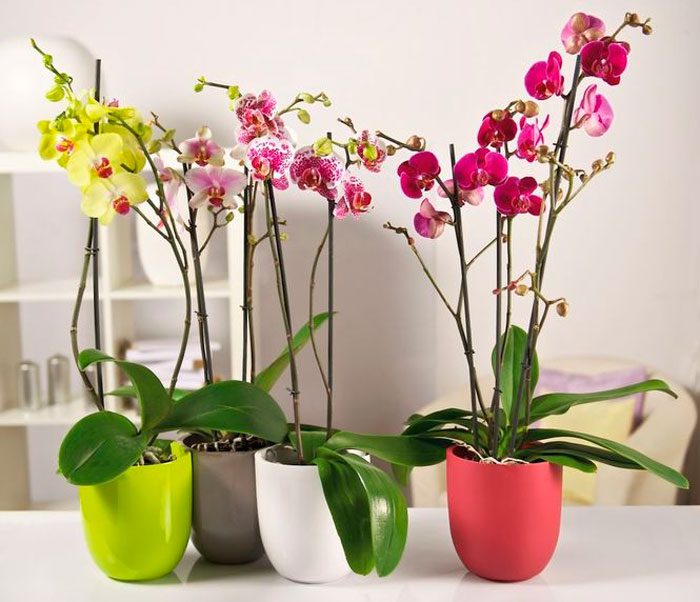
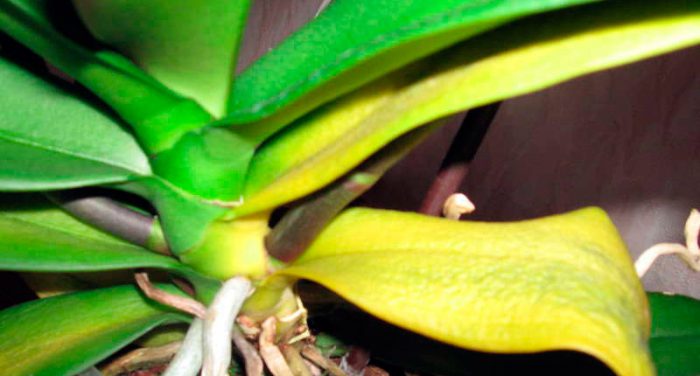



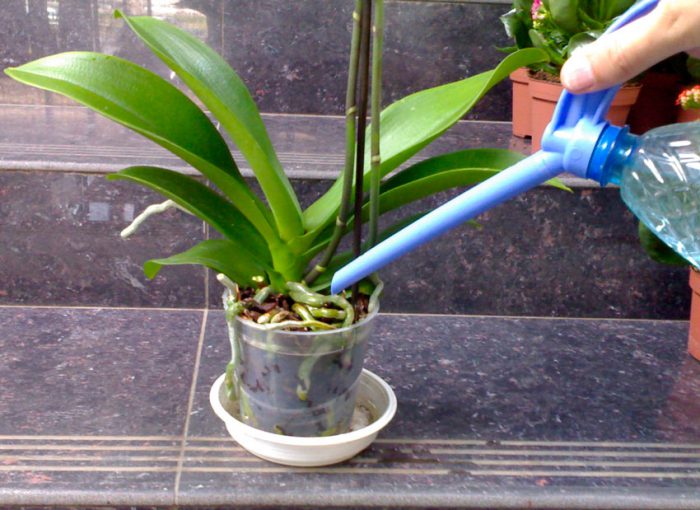







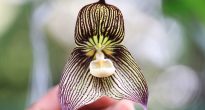
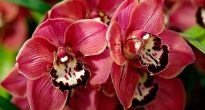


thanks for the good information
Very useful information. Thank!
Thanks for the good information
Very helpful
Thanks a lot. But if the air is dry and there is a plate nearby
with water, you can read what is humid air? I'm sorry for the mistakes
Thanks for the information, I just needed help with leaving.
Valentine I was given an orchid for my birthday, so this information is very useful for me. Thank you!
I got an orchid. I read everything, it is useful, thanks, but ... nowhere is it written how to handle the roots. I mean when the roots are long - what to do with them. they grow and grow, they cannot endlessly. Should they be shortened or what to do with them? Thank you in advance
I still didn't understand how many times a week to water. Or look at dry ground?
Depends on the size of the flower itself and the pot. I have several babies and one bucket-sized pot. Malyshkin dry out in 3-4 days dry, and the bucket dries for 2 weeks. I water it by soaking in water for a day, wait for the soil to dry completely and only then water it again.
Yes, the information is good, but I must add that the orchid is a flower for the lazy. Not watered - she is grateful, watered anyway, grateful, but I water with the addition of hydrogen peroxide (for 1l.water2tbs
Thank you Very useful information
thanks for the info
I still didn't understand how many times a week to water. Or look at dry ground?
thanks for the info
Yes, the information is good, but I must add that the orchid is a flower for the lazy. Not watered, she is grateful, watered anyway, grateful, and I water with the addition of hydrogen peroxide (for 1l.water2tbs
First time I read really good tips for orchid care! I myself have been successfully growing orchids for a long time and I was amazed by the advice of "experts"
Thank. Very useful information.
I have one orchid growing since 2017, it blooms continuously. I water it when condensation disappears on the walls of the transparent pot, I recently transplanted it into a new pot, all the roots were healthy
I only have one white orchid, which variety I don't know. It was presented. Now it has faded and one stem of 2 has dried up. On the second, some kind of process grows. Now I will study care according to your advice. Thank.
Why do droplets of sweet juice appear on the orchid peduncle? It's a disease?
Please tell me why an orchid should have a transparent pot?
Thank)
Because the roots photosynthesize - that is, if they block access to light, the plant will die